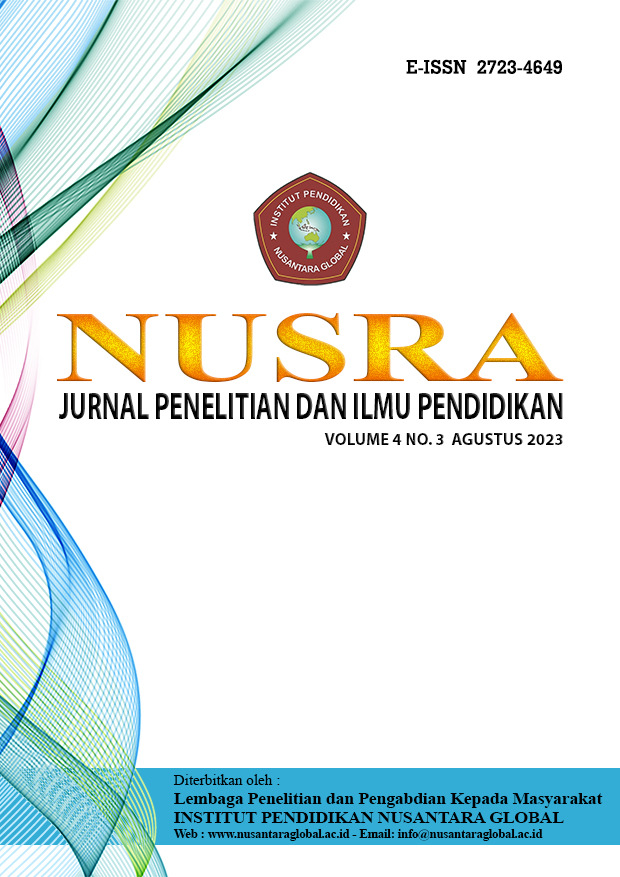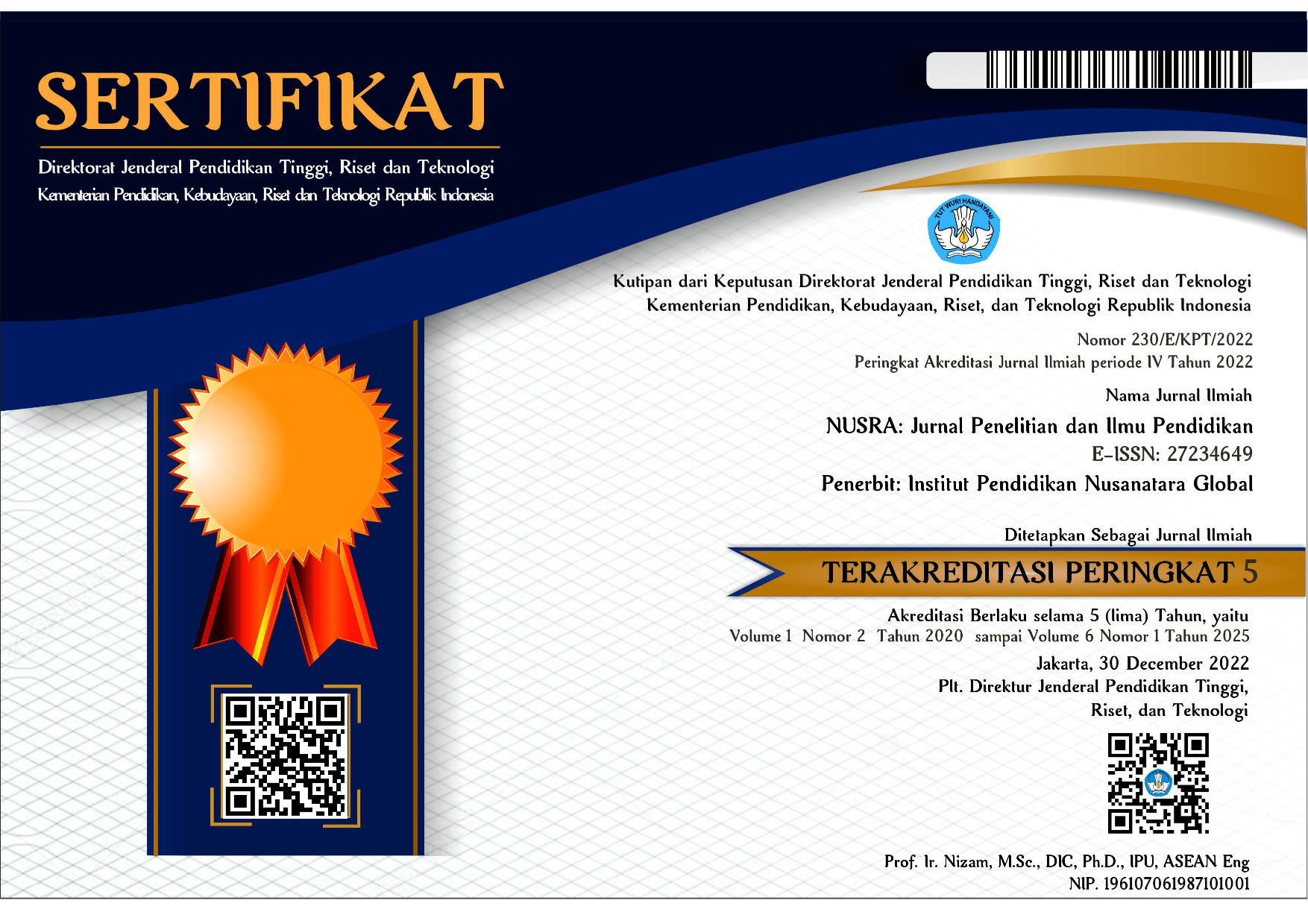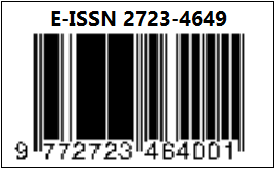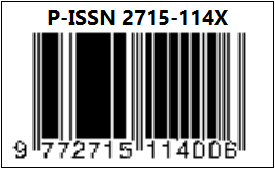KEMAMPUAN PEMECAHAN MASALAH MATEMATIS SISWA PADA MATERI OPERASI HITUNG BILANGAN KELAS III UPT SD NEGERI 160 GRESIK
DOI:
https://doi.org/10.55681/nusra.v4i3.1259Keywords:
Problem Solving Ability, Polya Stages, Elementary StudentAbstract
This study aims to determine students' mathematical problem-solving abilities in material arithmetic operations grade 3 elementary school 160 Gresik, to describe students' problem-solving abilities using Polya stages. This research includes descriptive qualitative research in which the research describes the phenomena that occur. Data collection techniques with tests and interviews. The target of this research is grade 3 students. The methods used are tests and interviews. The results showed that the students' mathematical problem-solving abilities on arithmetic operations for grade 3 were quite good with the analysis results being categorized into, High ability (KT) was 5 students with a presentation of 20%, and Medium ability (KS) was 7 students with presentation of 28%, while the Low ability (KR) is as many as 13 students with a presentation of 52%. Analysis of problem-solving abilities through the Polya stages is able to become a new insight for teachers in understanding students' problem-solving abilities in material arithmetic operations. However, there are limitations in this study that can only be applied to problems that are problem solving in nature
Downloads
References
Alfiandari, L., Alman, A., & Sahidi, S. (2022). Kemampuan Pemecahan Masalah Matematis dalam Menyelesaikan Soal Cerita Ditinjau dari Langkah- Langkah Polya Materi Bangun Ruang Madrasah Ibtidaiyah. Jurnal Papeda: Jurnal Publikasi Pendidikan Dasar, 4(1), 34–40.
Gazali, M., & Januardi, J. (2023). Analisis Model Pembelajaran Berbasis Masalah (Problem Based Learning) Dalam Mengembangkan Berpikir Kritis Peserta Didik Di Sd Negeri 1 Praya Tengah. NUSRA: Jurnal Penelitian dan Ilmu Pendidikan, 4(2), 304-313.
Harahap, R. (2012). Perbedaan Kemampuan Komunikasi dan Koneksi Matematika Siswa Melalui Pembelajaran Kontekstual dengan Kooperatif Tipe STAD di SMP Al-Washiyah 8 Medan. Pendidikan Matematika Paradigma, 5, 129.
Lestari, V. P., Saputro, B. A., & Sukamto, S. (2020). Analisis Kemampuan Memecahkan Masalah Matematika Materi Debit Pada Kelas V Sekolah Dasar. EduBasic Journal: Jurnal Pendidikan Dasar, 2(2), 107–116.
Manalu, M. (2021). Peningkatan Kemampuan Pemecahan Masalah Matematik Siswa SMA melalui Strategi REACT (Relating, Experiencing, Applying, Cooperating, Transferring) di SMA SW Parsaoran. Jurnal Pendidikan Matematika, 4(1), 43–64.
Meilani, M., & Maspupah, A. (2019). Analisis Kemampuan Pemecahan Masalah SD Pada Materi KPK dan FPB. Journal on Education, 2(1), 25–35.
Mukrimatin, N. A., Murtono, M., & Wanabuliandari, S. (2018). Pemahaman Konsep Matematika Siswa Kelas V SD Negeri Rau Kedung Jepara Pada Materi Perkalian Pecahan. ANARGYA: Jurnal Ilmiah Pendidikan Matematika, 1(1), 67–71.
Sugiyono, P. D. (2017). Metode penelitian bisnis: pendekatan kuantitatif, kualitatif, kombinasi, dan R&D. Penerbit CV. Alfabeta: Bandung, 225, 87.
Sumarmo, U. 1994. Suatu Alternatif
Pengajaran untuk Meningkatkan Kemampuan Pemecahan Masalah pada Guru dan Siswa Sekolah Menengah Atas di Kodya Bandung. Laporan Penelitian IKIP Bandung. Tidak diterbitkan.
Sumarmo, U. (2000). Pengembangan model pembelajaran matematika untuk meningkatkan kemampuan intelektual tingkat tinggi siswa sekolah dasar. Laporan Hibah Bersaing. Bandung: FPMIPA IKIP Bandung.
Sumartini, T. S. (2016). Kemampuan Pemecahan Masalah Matematika dalam Menyelesaikan Soal Cerita Berdasarkan Langkah Polya. Jurnal Pendidikan Matematika STKIP Garut, 5(2), 1–7. https://scholar.googleusercontent.com/scholar?q=cache:jfDgJQUQWmcJ:scholar.google.com/+Peningkatan+Kemampuan+Pemecahan+Masalah+Matematis+Siswa+melalui+Pembelajaran+Berbasis+Masalah&hl=id&as_sdt=0,5
Downloads
Published
How to Cite
Issue
Section
License
Copyright (c) 2023 NUSRA: Jurnal Penelitian dan Ilmu Pendidikan

This work is licensed under a Creative Commons Attribution-ShareAlike 4.0 International License.














